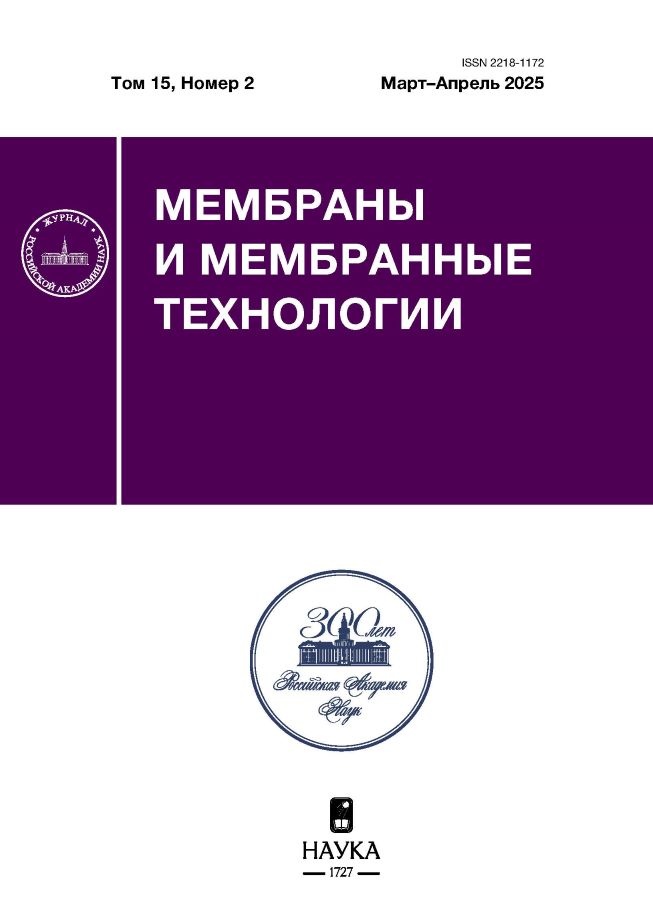卷 15, 编号 2 (2025)
Articles
Cross-linked polydecylmethylsiloxane membranes for the separation of volatile organic compounds: effect of cross-linker amount
摘要
Membrane-based recovery of volatile organic compound (VOC) vapors is a promising separation process both from the perspective of reducing environmental impact and for resource conservation. Silicone rubber-based membranes are traditionally used for VOC separation from gaseous streams. In this work, highly selective polydecylmethylsiloxane (C10)-based membranes were studied, with a focus on the effect of cross-linking degree — varied by changing the 1-decene/1,7-octadiene (OD) ratio — on transport and separation properties. The influence of cross-linking on the sorption behavior of C10 was evaluated. Based on spectroscopic ellipsometry data, Flory–Huggins interaction parameters (χ₀, χ₁), Henry’s solubility constants (S₀), and swelling coefficients of thin films of cross-linked C10 in saturated VOC vapors (n-octane, iso-octane, toluene, butyl acetate) were determined. The highest sorption values were observed for iso-octane, which correlates with earlier findings for polydimethylsiloxanes. However, no direct correlation was found between sorption properties of C10 and VOC vapor transport through the membranes. The most suitable parameter for predicting changes in VOC vapor permeability across the series of cross-linked C10 samples was found to be χ₁ — the interaction parameter reflecting changes in solubility with increasing sorbate concentration. In binary VOC/N₂ separation, both permeability and selectivity decreased with increasing cross-linking degree, especially for iso-octane, likely due to reduced free volume in the polymer network. Membranes with lower cross-linking density showed the smallest (4–12%) relative change in nitrogen permeability (change in permeability coefficient when transitioning from pure gases to vapor-gas mixtures), which may be related to structural changes in the membrane at high OD concentration.
 89-106
89-106


Application of pervaporation and vapor-phase membrane method for concentrating of furfural from aqueous solutions
摘要
The relevance of increasing furfural production is supported by the expanding range of its applications. Furfural is produced exclusively through biomass hydrolysis, and rectification—which involves significant capital and operational costs—is currently the predominant method for obtaining commercial-grade furfural. Improving the efficiency of furfural concentration and reducing energy consumption can be achieved through membrane technology. This paper reviews the current state of research on the application of pervaporation and vapor-phase membrane separation, membrane materials, and membranes for furfural concentration. An analysis of published experimental data is presented, including an assessment of the membrane’s contribution to the separation process. It is shown that the furfural/water separation factor during phase transition is approximately 7 for a solution containing 6 wt.% furfural and exhibits weak temperature dependence. For a PDMS (polydimethylsiloxane) membrane, the furfural/water separation factor from 3.9 to 7.5. Using mathematical modeling of the vapor-phase membrane separation of furfural from hydrolysate, the expected process performance was calculated for an available PDMS-based membrane. The advantages of membrane technology over rectification are demonstrated: Production of a vapor stream with a higher organic phase content (35–50 wt.% vs. 27 wt.%). Higher proportion of furfural directed for further purification after decantation (87% of the initial stream vs. 70%).
 107-120
107-120


Influence of ion-plasma fibers treatment and silica nanoparticles on porous structure of Polikon anion-exchange membranes
摘要
The physicochemical properties and characteristics of the porous structure of “Polikon A” composite anion-exchange membranes, obtained by the method of polycondensation filling of polyester fiber, are studied. It is established that the total porosity, the specific surface area and specific moisture capacity of “Polikon A” composite membranes are comparable with these characteristics for the “Polikon K” membranes and are significantly higher than for the heterogeneous ion-exchange MA-40 membrane. It is found that the method of preparing silica nanoparticles, as well as preliminary ion-plasma treatment of fibers, significantly influence on the porous structure of the Polikon A membranes based on lavsan.
 121-129
121-129


Composite cation exchange membrane based оn а polyvinyldene fluoride substrate filled with perfluorinated sulfopolymer
摘要
The composite cation-exchange membrane is fabricated by impregnating an inert isotropic substrate with a three-dimensional network of nanofibers made of a perfluorinated sulfonated polymer. The membrane's surface morphology and structure are analyzed using scanning electron microscopy. The thickness, exchange capacity, moisture content, volume fractions of the gel phase, concentration dependences of the specific electrical conductivity, diffusion permeability and counterion transport numbers of the membranes are determined in NaCl solutions. These characteristics are compared with those of the commercial reinforced membrane Nafion® N438. The developed membrane exhibits higher selectivity and lower electrical resistance than the commercial benchmark while requiring less perfluorinated sulfonated polymer for production. The combination of these factors indicates the prospects of the developed domestic membrane and its potential competitiveness.
 130-140
130-140


Modified lag time method for determination of gas transfer parameters of membrane layers of bilayer membrane
摘要
For the first time, a modified lag time method has been developed to determine the gas transfer parameters of layers of bilayer membrane. Analytical expressions for the lag time of gas pressure change depending on the position of the bilayer membrane in the membrane system are obtained. For the first time, a method is proposed to determine the permeabilities, diffusion coefficients and gas solubility of each layer of a bilayer membrane. It can also be used to evaluate the degree of influence of different methods of membrane layer modification and methods of bilayer membrane formation on the gas transfer parameters of the membrane and its layers.
 141-150
141-150











